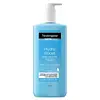What's inside
What's inside
 Key Ingredients
Key Ingredients

 Benefits
Benefits

 Concerns
Concerns

 Ingredients Side-by-side
Ingredients Side-by-side

Water
Skin ConditioningGlycerin
HumectantIsopropyl Palmitate
EmollientPetrolatum
EmollientCetyl Alcohol
EmollientDimethicone
EmollientSodium Hyaluronate
HumectantEthylhexylglycerin
Skin ConditioningCaprylyl Glycol
EmollientCetearyl Olivate
Sorbitan Olivate
EmulsifyingCarbomer
Emulsion StabilisingSodium Polyacrylate
AbsorbentSodium Hydroxide
BufferingTocopherol
AntioxidantPhenoxyethanol
PreservativeParfum
MaskingCI 42090
Cosmetic ColorantGlycerin
HumectantUrea
BufferingCetearyl Alcohol
EmollientGlyceryl Glucoside
HumectantCyclomethicone
EmollientSodium Lactate
BufferingButyrospermum Parkii Butter
Skin ConditioningCaprylic/Capric Triglyceride
MaskingMethylpropanediol
SolventOctyldodecanol
EmollientDicaprylyl Ether
EmollientTapioca Starch
Glyceryl Stearate Se
EmulsifyingHydrogenated Coco-Glycerides
EmollientArginine Hcl
Skin ConditioningSodium PCA
HumectantDimethiconol
EmollientLactic Acid
BufferingCarnitine
CleansingCeramide NP
Skin ConditioningMannitol
HumectantSerine
MaskingSucrose
HumectantCitrulline
Skin ConditioningGlycogen
HumectantAlanine
MaskingThreonine
Glutamic Acid
HumectantSodium Chloride
MaskingSodium Cetearyl Sulfate
Cleansing1,2-Hexanediol
Skin ConditioningGlycerin, Urea, Cetearyl Alcohol, Glyceryl Glucoside, Cyclomethicone, Sodium Lactate, Butyrospermum Parkii Butter, Caprylic/Capric Triglyceride, Methylpropanediol, Octyldodecanol, Dicaprylyl Ether, Tapioca Starch, Glyceryl Stearate Se, Hydrogenated Coco-Glycerides, Arginine Hcl, Sodium PCA, Dimethiconol, Lactic Acid, Carnitine, Ceramide NP, Mannitol, Serine, Sucrose, Citrulline, Glycogen, Alanine, Threonine, Glutamic Acid, Sodium Chloride, Sodium Cetearyl Sulfate, 1,2-Hexanediol
Ingredients Explained
These ingredients are found in both products.
Ingredients higher up in an ingredient list are typically present in a larger amount.
Glycerin is already naturally found in your skin. It helps moisturize and protect your skin.
A study from 2016 found glycerin to be more effective as a humectant than AHAs and hyaluronic acid.
As a humectant, it helps the skin stay hydrated by pulling moisture to your skin. The low molecular weight of glycerin allows it to pull moisture into the deeper layers of your skin.
Hydrated skin improves your skin barrier; Your skin barrier helps protect against irritants and bacteria.
Glycerin has also been found to have antimicrobial and antiviral properties. Due to these properties, glycerin is often used in wound and burn treatments.
In cosmetics, glycerin is usually derived from plants such as soybean or palm. However, it can also be sourced from animals, such as tallow or animal fat.
This ingredient is organic, colorless, odorless, and non-toxic.
Glycerin is the name for this ingredient in American English. British English uses Glycerol/Glycerine.
Learn more about Glycerin